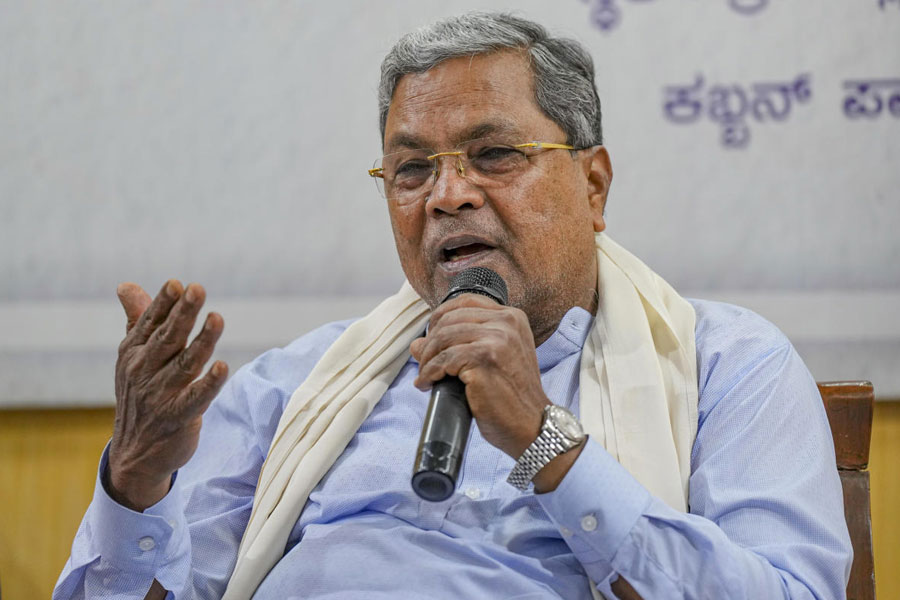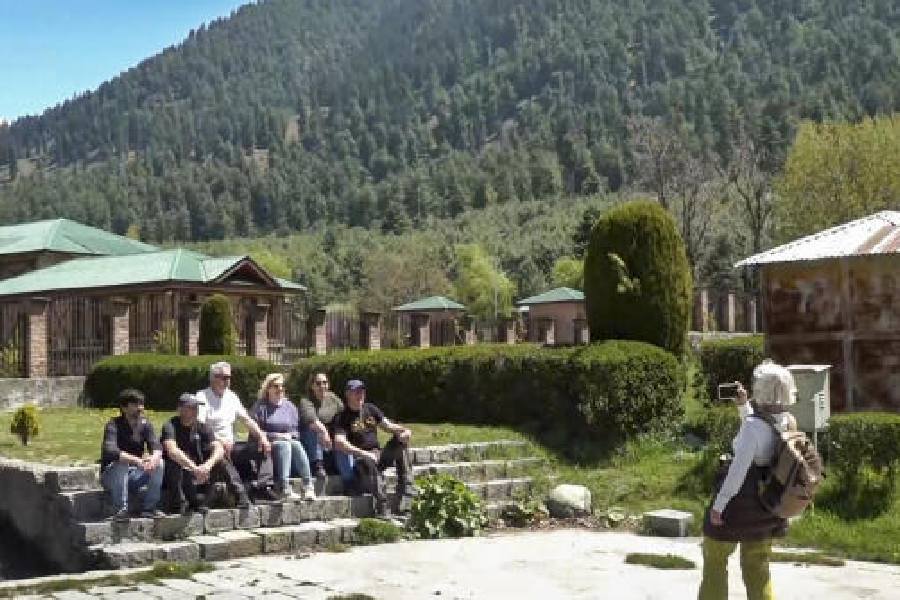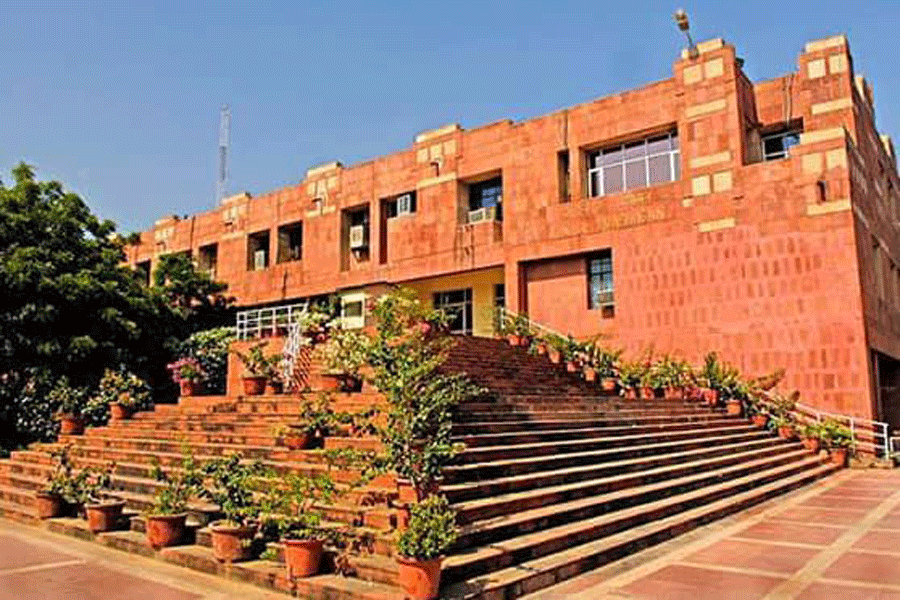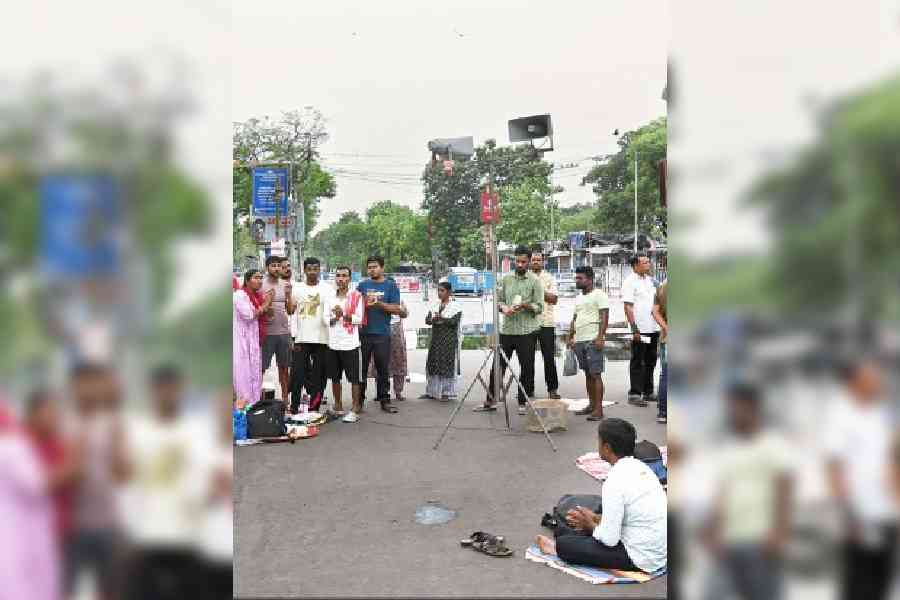 |
| Location courtesy: Crossword, Elgin Road. Model: Farheen Aman, a student of Bhawanipur College who we caught browsing. Picture by Anindya Shankar Ray |
Titles published per year in India: Around 95,000.
Market size: Rs 12,000crore.
Year-on-year growth: Around 30 per cent.
Reading population: 600 million.
What do these figures mean? They mean that India is “the MOST important market in the planet” for Jeffrey Archer.
“It has the biggest readership and is growing the fastest. Kane and Abel has been read by 50 million people in India. So, yes, India is very, very important,” the bestselling author told t2 from his London office last week. No wonder Lord Archer will be India-bound twice in the next seven months. And yes, he will come to Calcutta both times.
No wonder also that UK-based publishing house Bloomsbury, best-known for discovering Harry Potter creator J.K. Rowling, has just stepped into India. The formal launch is on September 21, in New Delhi.
 |
Chapter 1: India calling
A number of foreign publishers have come to India in the past few years. Hachette India started publishing in 2009, Pan Macmillan India in 2010. Last year, The Aleph Book Company was set up by David Davidar, after his return from Canada, in partnership with Rupa Publications. Other big players like Penguin, Random House and HarperCollins have been here for a while.
Set up in the UK 26 years back, Bloomsbury, which publishes the likes of Khaled Hosseini (The Kite Runner) and Elizabeth Gilbert (Eat Pray Love), ventured into the US in 1998 and Australia in 2010. The next stop had to be India.
“India is another hugely important market for English language books, and it was therefore the obvious next step for us,” Alexandra Pringle, the editor-in-chief of Bloomsbury, said via email.
Bloomsbury will not just publish their foreign-originated titles here, they are on the lookout for local talent, which “will be published by us in the UK and the US, thereby offering Indian writers a truly global publication,” added Pringle.
The just-appointed Bloomsbury India publisher, Diya Kar Hazra, is a Calcutta girl. She echoed Pringle’s promise. “I’ll be looking for authors I believe in, those who are in it for the long haul. I’ll be committed to championing my authors outside India as well, trying to get them as wide a readership as possible.”
The Bloomsbury India list will be inaugurated with William Dalrymple’s Return of a King: The Battle for Afghanistan this December. Then follows Manil Suri (The City of Devi),
Jaspreet Singh (Helium), Romesh Gunesekera, Jhumpa Lahiri, Pico Iyer, Kalyan Ray and more.
Pan Macmillan too is very bullish about India and its local publishing programme. Its Indian arm is seeing a growth of 10-15 per cent a year. “At the moment we are very excited about the just-released The Shadow Throne by debut author Aroon Raman,” said Saugata Mukherjee, publisher, Picador, Pan and Macmillan India.
Ditto for Penguin, which enjoyed first-mover advantage in the Indian market and has had a deep impact on English language publishing here. Penguin India is currently celebrating its 25th year. “We’ve always published the best and the most exciting new writing from and on India. This is what has resulted in the varied and impressive publishing list that we have today,” pointed out Udayan Mitra, the publisher for Penguin imprints Allen Lane and Portfolio.
Topped by Nobel-winner Orhan Pamuk’s Silent House, their September list has Indian titles like Gurcharan Das’s India Grows at Night and Nayantara Sahgal’s Indira Gandhi: Tryst with Power.
Chapter 2: The back story
The picture today is a far cry from the time when Indian authors in English had to look abroad to get published. RK Narayan, the man credited with taking Indian writing in English to the world, could only get a publisher with help from his friend Graham Greene.
“I started writing in the 1950s. Till about the 1960s, publishers in India were only into textbooks and specialised publishing. I survived by writing mostly for magazines and newspapers,” recalled Ruskin Bond, the grand old man of the Indian publishing story, fairy tale if you will.
Rupa, which started out as a distributor in 1936, graduated to publishing in 1960, starting with Siddhartha by Hermann Hesse. In 1987 came Penguin. “It was only around this time that my novellas and short story compilations started coming out,” Ruskin, now 82, told t2 from his home in Landour, near Mussoorie.
“There’s been a huge change in the last 10 years,” said writer-filmmaker Ruchir Joshi, whose debut novel The Last Jet-Engine Laugh was published by HarperCollins in 2001. He’s now writing his second fiction novel, which is set in Calcutta during World War II. “Many of the big publishers in India have come in the last 10 years or so. While margins are shrinking abroad, Indian publishers have a lot more money and are trying out different writers and new themes, hoping for one that will click,” he added.
According to a 2011 FICCI report, India has — hold your breath — 19,000 publishers. These include the big national players to the tiny local ones, covering our 22 official languages and more. India today has a robust line-up of home-grown English language publishers too, including Roli Books, Westland, Sage, Jaico and many more.
So, why are foreign publishers still interested to set up shop and shelf in India?
Chapter 3: Markets & margins
A part of the answer possibly lies beyond our shores. There’s a consensus that book reading is dwindling in the more mature reading societies. “The publishing industry is flourishing in India while in the US and Europe, many publishers are having to cut back,” said author Chitra Banerjee Divakaruni, whose repertoire includes The Palace of Illusions and The Mistress of Spices. Hailing from Calcutta, Chitra is now based in Houston.
While most publishers agree that physical book margins have been falling in Europe and America — it’s said to be worse in Australia — Alexandra of Bloomsbury says it’s not readership figures that are dwindling. “What is happening is that the e-book revolution has meant that slightly fewer people are reading physical books and dramatically more people are reading e-books. This is particularly the case with crime and other genres in fiction.”
E-books. That one word on which everyone — be it writer, publisher, bookseller or reader — has many, many words to say. We’ll get to that in a bit.
The mood of the traditionally big book markets may be understood from programmes like the Six Book Challenge in the UK. According to the website of The Reading Agency, London, “one in six adults struggles to read. The Six Book Challenge builds people’s reading confidence and literacy skills, improving their life chances…”
Last week, @AmandaPCraig, a literary critic with The Times, tweeted: “Please RT my call for publishers to advertise in newspaper Books Pages. The Times now down to 4 pages.”
In September 2011, renowned bookshop chain Borders folded up in the US.
These are isolated incidents, yes, but who can ignore the tale they are telling?
But India’s book boom is not just about Europe-America’s doom. The world seems interested in the stories India is telling and the way her writers are telling them. No one puts it better than Alexandra. “There is often an inventiveness in the writing, a freshness of expression and lyricism of language that sets Indian writers apart from authors writing in English from other countries.”
Chapter 4: Write of passage
Okay, so India is hot (and we don’t mean the weather) for foreign publishers, so are our writers. But what does all this translate into?
“It means for the first time, an Indian author can think of making a living just out of writing. This was unthinkable even four years back,” said Amish Tripathi, the author of the Shiva trilogy (Westland). This IIM Calcutta alumnus quit his banking job last year after his first book The Immortals of Meluha (2010) became a runaway success. Together with book 2, The Secret of the Nagas, Amish has sold 7.5 lakh copies, doing business of Rs 17crore. Book 3, The Oath of the Vayuputras, is expected later this year, with a huge print run.
When talking about big numbers, who can ignore the man who started it all — Chetan Bhagat. The manner in which this IIT-IIM grad changed the contours of Indian publishing is nothing short of a fantasy tale. Chetan’s five fiction titles — from Five Point Someone (2004) to Revolution 2020 (2011) — have together sold some 50 lakh copies. That’s nearly the population of Singapore!
Chetan’s success gave rise to the “Chetan Bhagat formula”, which spawned genres within the genre of Indian popular fiction. So, there is college fiction, workplace fiction, fantasy fiction, chick-lit and now even lad lit — most of them written by young Indian writers who pen stories of the everyday.
“I think publishers are trying to recreate the formula. And authors are, I guess, getting inspired, which is a good thing. But ultimately, the book has to be good,” Chetan had told t2 in an earlier interview.
The renewed interest in reading has rubbed off on non-fiction too. Raju Barman of Rupa says the company today has a vibrant line-up of motivational, self-help, health and nutrition, yoga and even poetry titles.
Agrees Udayan of Penguin. “Over the last few years, there has been a large readership for general non-fiction... biographies, memoirs, as also business books. Another popular segment is self-help,” he said, adding that there was still great scope for books on cinema and sports in India.
Saurav Jha, who wrote The Upside Down Book of Nuclear Power (HarperCollins) in 2010, however, says a writer of non-fiction still has to struggle in India. “Publishers are very choosy about non-fiction, far more than fiction,” he said. The print run is smaller too. A non-fiction book selling 4,000 would be “good”. That figure is at least 10,000 for fiction.
Chapter 5: Little India, large India
There are two other factors that we must pore over. First, pricing. Chetan Bhagat changed the rules of the game by pricing his books at Rs 95 (since 2011 it’s Rs 140). Suddenly young India could buy a book with its weekly pocket money. A reminder of the publishing masterstroke of Penguin Books founder Allen Lane, who famously came up with paperbacks “cheap enough to be sold from a vending machine” in Britain.
Penguin India now has Metro Reads, which is light reading at an affordable price. In the last couple of years, Penguin has signed up young authors like Ravinder Singh, who came out with Can Love Happen Twice, a bestselling sequel to his hugely popular I Too Had a Love Story. Even as they continue to publish Amitav Ghosh, Vikram Seth and Orhan Pamuk, Penguin has opened doors to debut authors like Vibha Batra (Sweet Sixteen) and Siddharth Narayan (Naughty Men).
The Random House list includes Booker-winner Alan Hollinghurst (The Swimming-Pool Library) to newbie Naomi Dutta (The 6pm Slot). Today, of course, Random House is a household — or should we say bedroom — name across the world, thanks to that game-changer called Fifty Shades of Grey!
Devapriya Roy, the author of chick-lit novel The Vague Woman’s Handbook (HarperCollins), agrees that it is easier now than ever before for a new author to get published. “And these books can truly have an India focus,” said the Calcutta girl. Now that Indian writers don’t need to look West, “they are free from the Kerala monsoon and the ripe mango novels that Westerners seemed to want out of us,” she laughed.
Readers too are turning writers. In August, Penguin India ran a short story writing contest. Selected and edited by Ravinder Singh, 25 winning entries will be compiled into a Penguin book. “There are so many readers who now feel that they have a writer in them just waiting to come out. I believe everyone has at least one story,” Ravinder told t2 last month. It’s no surprise that Penguin has received some 3,000 entries.
This democratisation of the trade list leads us to our second point — the spread of English language books beyond the big cities. The market penetration (don’t think of Grey!) was abysmally poor for non-academic English books in the country till even some years back.
“Let’s face it, earlier publishing was a south Mumbai-south Delhi thing, not an Indian industry. Today it is genuinely a pan-Indian industry,” pointed out Amish.
Ruskin Bond credits this to the steady spread of English-medium education to small town and mofussil India.
Such is the power of this new India that Chetan Bhagat, who based his first story in the elite institution of IIT Delhi, placed Book 3, The 3 Mistakes of my Life, in Ahmedabad and book 5 in Varanasi. In Bengal, bookstore chain Crossword has opened stores in Durgapur and Siliguri and is eyeing Burdwan town and Chandernagore next. “The Durgapur and Siliguri stores do almost as well as our Calcutta outlets,” said franchise owner Sidharth Pansari.
Internet retailers like Flipkart and Infibeam now reach books to the reader’s doorstep, whether in Bandra or Balasore.
Then, of course, there’s Jaipur, the epicentre of literary India’s seismic churn. Since 2006, this Rajasthani capital has hosted some of the best and biggest names of the book world at the Jaipur Literature Festival. Today there are Lit Meets in almost every corner of the subcontinent — Kerala, Calcutta, Mumbai, Bhutan, Sri Lanka, Kathmandu, Dhaka.... Author interactions, book readings, discussions, debates, autographs, photo-ops — the reader has never been this close to the writer.
The result? More books being written, more books being sold, more books being read.
Chapter 6: E-reads
The proverbial bookworm is said to be facing a loss of habitat, what with paper books making way for kilobytes and Kindles. But that’s actually true just for the foreign bookworm. In the West and Australia, electronic books have changed publishing, book-buying and reading habits. Many foreign newspapers have commented that one of the reasons E.L. James’s kinky Fifty Shades trilogy became such a rage was because women could download the books on their e-readers and tablets and devour them with no one catching them in the act.
In India at the moment e-books command a zero-point-negligible share of the present market. For Pan Macmillan India, it’s 0.1 per cent of sales, said publisher Saugata. In comparison, it’s 20-21 per cent of total sales for the company in the UK and 35 per cent in the US.
One of the biggest challenges to the spread of e-books in India has been the unavailability of e-readers. Even if you managed to get your hands on an e-reader or owned a tablet PC, you couldn’t buy e-books in Indian rupees.
But that changed last month, with Amazon making its highly successful e-reader, Kindle, available at Croma stores in India (though not the backlit, 3G or touchscreen models). Indians who don’t have access to a Croma outlet (Calcuttans, for example) can order online and avail of free shipping. Indian books that have been digitised can now be bought from Amazon in Indian currency, apart from foreign titles.
E-books are gaining ground in India and industry watchers believe the next five years will see a steady rise. And e-books are not just changing how books are produced or procured. According to Amish, e-books will be a blessing for a fantasy writer like him. “What you get in my books is just 25 per cent of what’s in my head. Imagine, with an e-book, while I describe the city of Meluha, I can provide maps, city plans, the Indus Valley script and more through hyperlinks. E-books open up a world of possibilities.”
Chapter 7: Shop talk
Despite the buzz about e-books, brick-and-mortar book shops in India don’t feel threatened, at least for now. While Crossword opened its sixth Calcutta store on Jessore Road this week, Starmark has plans for a fifth store in Calcutta in the coming year.
Compare this with the UK, where e-books and Amazon discounts led to the closure of some 400 independent booksellers in the past 12 months and put a big player like Barnes & Noble in trouble.
“E-books are not a factor in India now, but Internet retailing is. And bookstores in south and west India have been impacted. But people come to a bookstore out of habit too, for the sheer pleasure of browsing. Also, only a certain section of people buy online,” said Starmark CEO Gautam Jatia.
Chapter 8: Quality Control
So today it’s easier to write, publish, buy and read books in India. But does everything that’s coming out of India make for good reading?
No.
Some people who have never written an essay in their life are churning out full-length novels. Spelling errors, grammatical horrors and editing terrors are rampant in some of these titles. Many are self-published or brought out by quick-buck businesses masquerading as publishers.
A publishing firm based in Calcutta promises aspiring writers their books will be in print “in approximately 14 days, from the time we have the computer-typed manuscript and your payment with us.”
Manreet Sodhi Someshwar, who has just come out with her third book, The Taj Conspiracy (Westland), is scathing in her assessment. “What’s coming out now in the name of books? They are like a can of Coke or a bag of chips! They are just for entertainment. They are the Ek Tha Tigers of the book world,” she said. Keen to cash in on the popular Indian fiction trend, these publishers “seem to follow the Nirma formula — sasta aur tikau (cheap and time-tested),” she fumed.
Another author said, “Such books make the market seem bottomless”.
Bottomless or bilious, the bottomline is they sell. And how. Recently, after the t2 Books page decided not to review a campus romance by a first-timer on grounds of quality control, the book’s first cache of 5,000 copies sold out and a re-print was ordered. So there.
Epilogue
Call it ugly, call it bad or call it good, all that counts on the racks is that books are in business.










